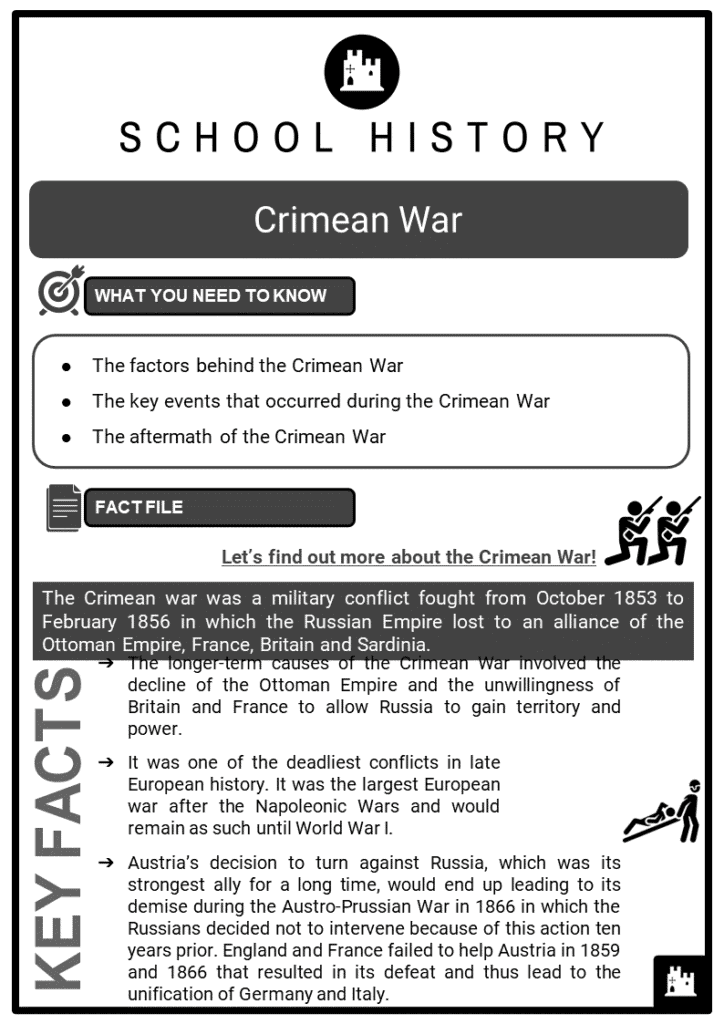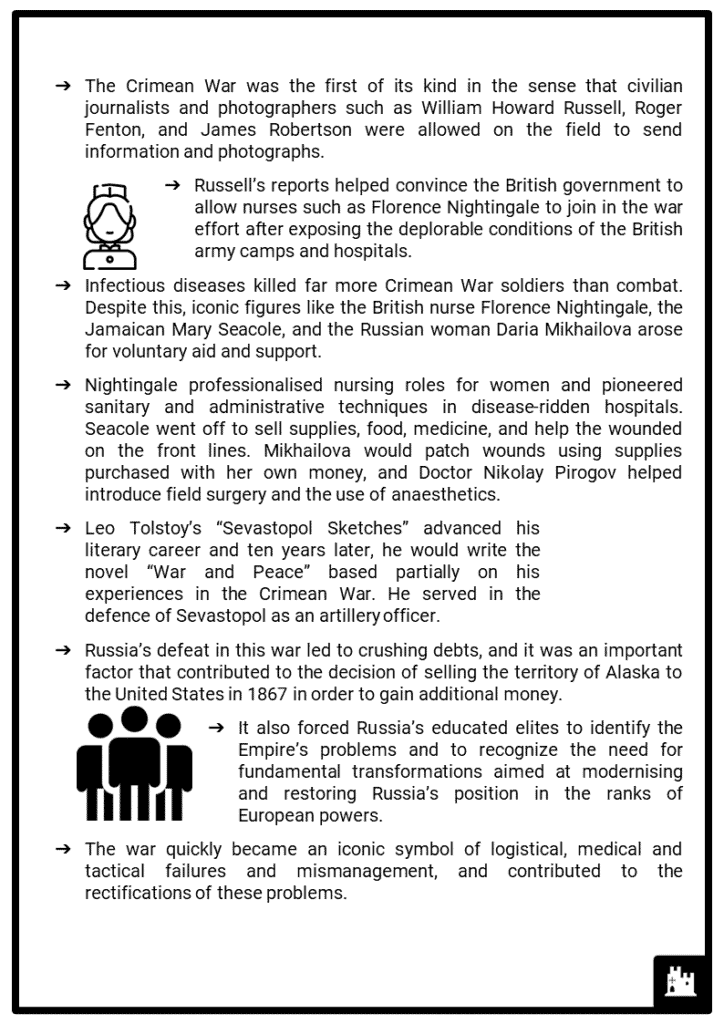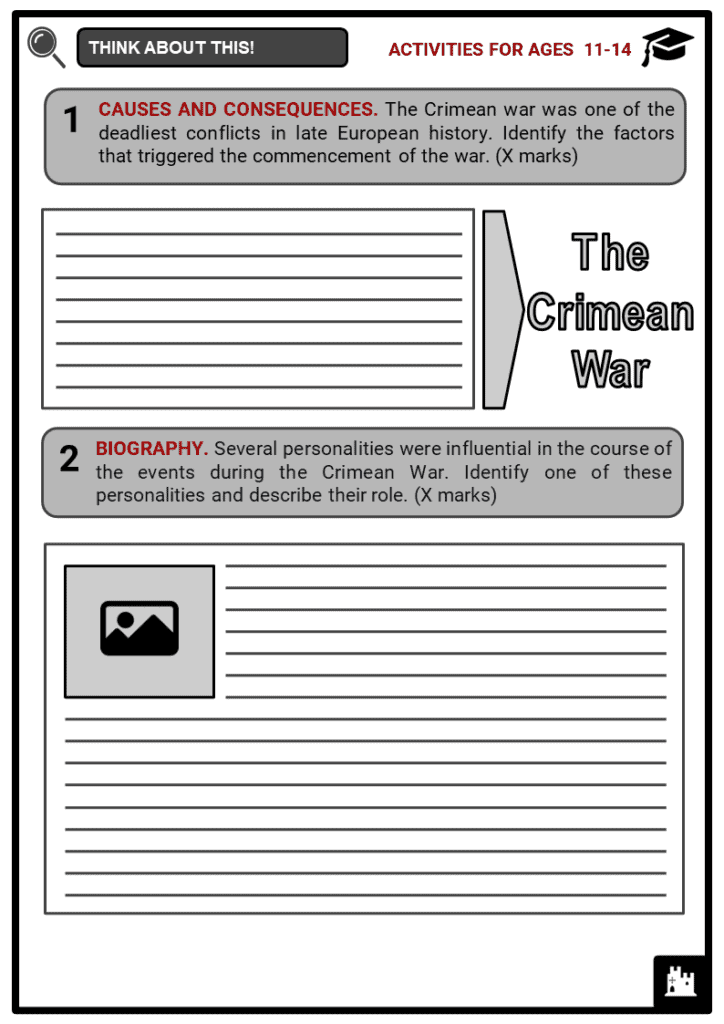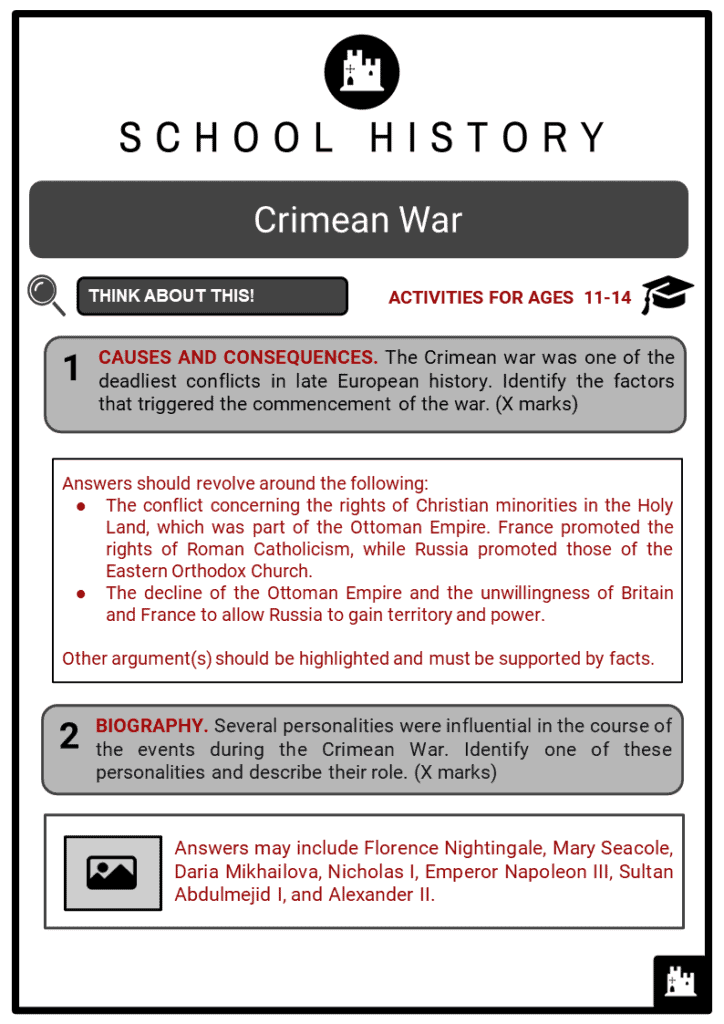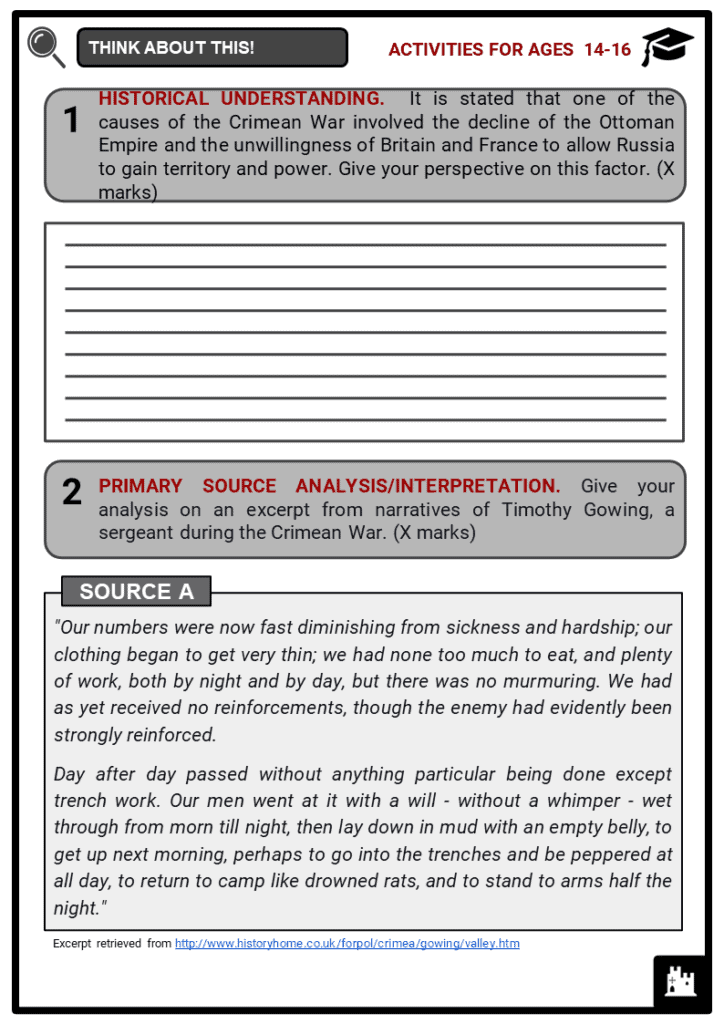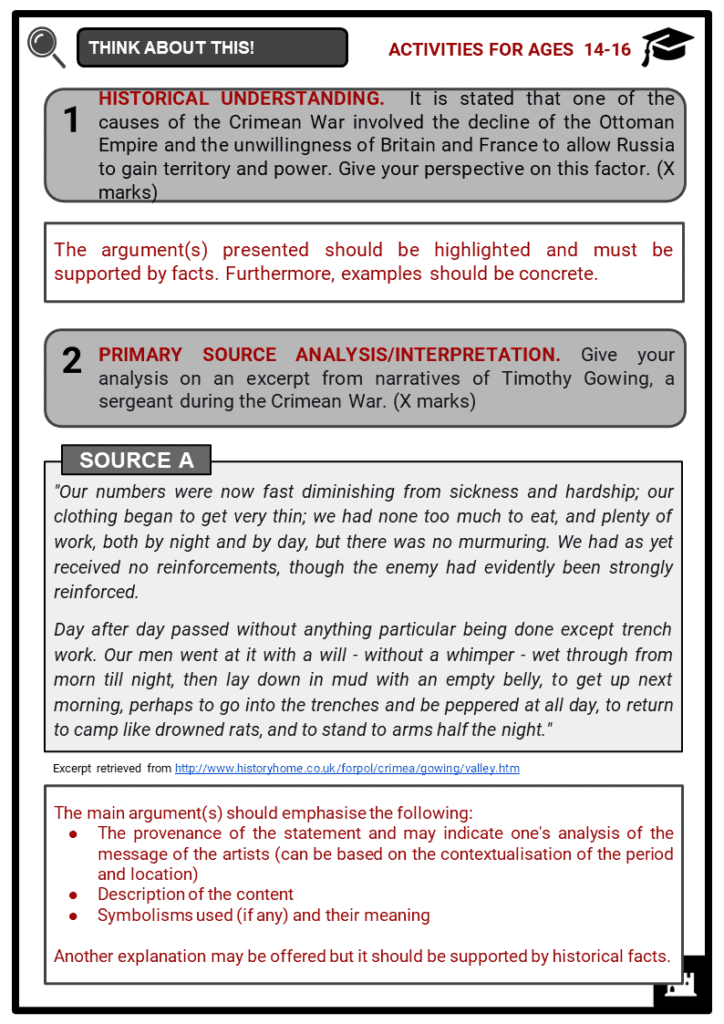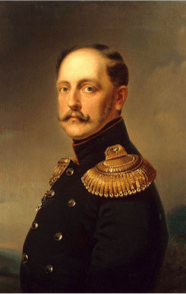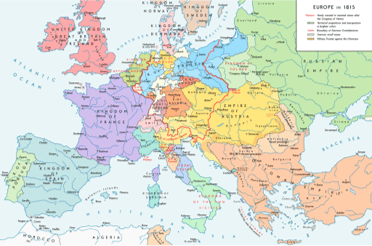Download Crimean War Worksheets
Do you want to save dozens of hours in time? Get your evenings and weekends back? Be able to teach Crimean War to your students?
Our worksheet bundle includes a fact file and printable worksheets and student activities. Perfect for both the classroom and homeschooling!
Table of Contents
Add a header to begin generating the table of contents
Summary
- The factors behind the Crimean War
- The key events that occurred during the Crimean War
- The aftermath of the Crimean War
Key Facts And Information
Let’s find out more about the Crimean War!
- The Crimean war was a military conflict fought from October 1853 to February 1856 in which the Russian Empire lost to an alliance of the Ottoman Empire, France, Britain and Sardinia.
- The longer-term causes of the Crimean War involved the decline of the Ottoman Empire and the unwillingness of Britain and France to allow Russia to gain territory and power.
- It was one of the deadliest conflicts in late European history. It was the largest European war after the Napoleonic Wars and would remain as such until World War I.
- Austria’s decision to turn against Russia, which was its strongest ally for a long time, would end up leading to its demise during the Austro-Prussian War in 1866 in which the Russians decided not to intervene because of this action ten years prior. England and France failed to help Austria in 1859 and 1866 that resulted in its defeat and thus lead to the unification of Germany and Italy.
- The Crimean War was the first of its kind in the sense that civilian journalists and photographers such as William Howard Russell, Roger Fenton, and James Robertson were allowed on the field to send information and photographs.
- Russell’s reports helped convince the British government to allow nurses such as Florence Nightingale to join in the war effort after exposing the deplorable conditions of the British army camps and hospitals.
- Infectious diseases killed far more Crimean War soldiers than combat. Despite this, iconic figures like the British nurse Florence Nightingale, the Jamaican Mary Seacole, and the Russian woman Daria Mikhailova arose for voluntary aid and support.
- Nightingale professionalised nursing roles for women and pioneered sanitary and administrative techniques in disease-ridden hospitals. Seacole went off to sell supplies, food, medicine, and help the wounded on the front lines. Mikhailova would patch wounds using supplies purchased with her own money, and Doctor Nikolay Pirogov helped introduce field surgery and the use of anaesthetics.
- Leo Tolstoy’s “Sevastopol Sketches” advanced his literary career and ten years later, he would write the novel “War and Peace” based partially on his experiences in the Crimean War. He served in the defence of Sevastopol as an artillery officer.
- Russia’s defeat in this war led to crushing debts, and it was an important factor that contributed to the decision of selling the territory of Alaska to the United States in 1867 in order to gain additional money.
- It also forced Russia’s educated elites to identify the Empire’s problems and to recognize the need for fundamental transformations aimed at modernising and restoring Russia’s position in the ranks of European powers.
- The war quickly became an iconic symbol of logistical, medical and tactical failures and mismanagement, and contributed to the rectifications of these problems.
Prologue
- The Crimean War was fought mainly on the Crimean Peninsula. Russia was expanding in the Danube River and had fought the Ottoman Empire which controlled this region in October 1853.
- France and Britain joined and backed up the Turkish forces in 1854, fearing a Russian expansion. In January 1855, the army of the Kingdom of Sardinia-Piedmont supported Turkey, England and France against Russia. Austria though, being an old ally of Russia, switched sides, thus leading to the culmination of the war.
Before the War
- The apparent immediate cause involved the rights of Christian minorities in the Holy Land, which was part of the Ottoman Empire. France promoted the rights of Roman Catholicism, while Russia promoted those of the Eastern Orthodox Church.
- The churches worked out their differences through a status quo, Nicholas I of Russia and the French Emperor Napoleon III refused to back down. Nicholas issued an ultimatum that the Orthodox subjects of the Ottoman Empire be placed under his protection.
- Britain attempted to mediate and arranged a compromise that Nicholas agreed to. The Ottomans would constantly change their mind regarding who would be the protector of Christians. The change would vary significantly depending on how close the army of Russia or France would be. Nicholas prepared for war nevertheless.
- When the Ottomans obtained promises of support from Britain and France and knew that their ships were close, they finally declared war on Russia in October 1853. The Ottoman Empire was already in a weakened state, and the other nations were aware of it. It is easy to simply state that this war happened under religious pretext. However, in actuality, this was only part of the reason. France and Britain suspected that Russia wanted Constantinople, which would lead to control of warm water ports since Russia was surrounded by frozen coastlines. This would also lead to a foothold in the mid-east. In fact, it can be stated that all major powers were trying to do so at the expense of the crumbling Ottoman Empire, or just as importantly, preventing their rivals from doing so.
- If any of the major powers were to seize control of such a territory, it would lead to a major imbalance of power, a threat to the balance of power, that was established by the Congress of Vienna in 1815.
- The emperor of France, Napoleon III, gained his title of emperor in 1851.
- After he couldn’t be constitutionally re-elected as president, he seized the power, and this act signalled the French re-entry into active power projection. Thus, he wanted to throw off the memories of the Napoleonic Wars, by increasing France’s international prestige. This was an opportunity for France, while Britain simply didn’t want to allow Russia to expand and unbalance the European powers.
- In July 1853, the Tsar sent his troops into the Danubian Principalities. Britain, hoping to maintain the Ottoman Empire as a bulwark against the expansion of Russian power in Asia, sent a fleet to the Dardanelles, where it joined another fleet sent by France.
- These principalities were then under Ottoman suzerainty- the pretext for the occupation was the protection of Christians from the Empire. Through this, the Ottoman Empire lost control of these principalities, but they would later be integrated into Austria after the Russians withdrew their forces. This would be a factor in the later independence of Wallachia and Moldavia.
- Sultan Abdulmejid I declared war on Russia once he was sure of the support from France and Britain. He proceeded to the attack, his armies moving on the Russian Army near the Danube later that month. Russia and the Ottoman Empire massed forces on two main fronts: the Caucasus and the Danube. Ottoman leader Omar Pasha managed to achieve some victories on the Danubian front.
- In the Caucasus, the Ottomans were able to stand ground with the help of Chechen Muslims led by Imam Shamil. Russia made this bold move as it was sure that no other countries would interfere. Another factor was that these principalities were near Austria, whom they had good terms with, especially because of the Hungarian Revolution of 1848.
- Without help from Russia, Austria probably would have suffered a great deal more during this revolution. Russia expected gratitude for this and wanted a free hand in settling its problems with the Ottoman Empire.
- The Ottoman Empire was dubbed the “sick man of Europe”, as it faced numerous defeats and internal struggles such as the Serbian Revolution and the Greek War of Independence, as well as restrictions imposed by the European powers.
The Crimean War
- The European powers continued to pursue diplomatic avenues regardless of the already open hostilities. The representatives of Britain, France, Austria and Prussia met in Vienna where they would draft a note that they hoped would be acceptable to both Russia and the Ottoman Empire. This note would be met with approval by Nicholas I, but Abdulmejid I rejected the proposal.
- On 23 November 1853, the Russian convoy of 3 battleships discovered the Ottoman fleet harboured in Sinop harbour. They destroyed a patrol squadron of Ottoman battleships while they were anchored in port under the defence of the onshore artillery garrison.
- The stated naval battle is noteworthy since it was the first battle that featured explosive naval shells. The press of Britain and France shaped public opinion to demand the war. Both used Sinop as the “casus belli” – act of war. After the Battle of Sinop, both France and Britain feared a quick victory of Russia over the Turks, and thus gave Russia an ultimatum.
- On 28 March 1854, after Russia ignored the Anglo-French ultimatum to withdraw from the Danubian Principalities, Britain and France declared war.
- Russia had a big army but their numbers were limited by the system of serfdom, since the serfs needed to work and the nobles didn’t want to give them rifles. The Russians crossed the Danube River and invaded Turkish Bulgaria.
- Austria, however, protested at Russia’s expansion, and they forced the Russians to withdraw in August of 1854. Austria occupied these territories after the Russian withdrawal.
- The occupation was a shock for the Russians since Austria had been an old ally that they helped many times in the past. However, Austria felt too threatened by the Russian troops in the Balkans. This action would cost Austria in the future, especially in the Austro-Prussian War, as Russia refused to aid them.
- One last peace attempt was made before the war broke out completely. The allies proposed the “Four Points” for ending the conflict, in addition to the Russia withdrawal, in August of 1854.
- The four points were:
- For Russia to renounce its protectorate over the Danubian Principalities.
- The Danube was to be opened up to foreign commerce.
- The Straits Convention of 1841, which allowed only Ottoman and Russian warships in the Black Sea, was to be revised.
- Russia was to abandon any claim granting it the right to interfere in Ottoman affairs.
- Russia declined and the allies agreed that further military action should be taken.
- The main assault against the Russian’s began in September-1854, with the allies landing in Crimea in an attempt to capture Sevastopol. Landing in Crimea would allow them to threaten Russia’s Black Sea trade, eliminate the Russian fleet and lay siege on major Russian cities while still maintaining logistical efficiency by the proximity to the Ottomans through the Balkans.
- The forces of the French and British navy didn’t know where to land in Crimea when they did they chose to land on an open beach. The landing took about five days and this showed a lack of ability from the Russian commander Alexander Menshikov for he did not take this clear opportunity to completely wipe out the allied forces.
- This unhindered mobilisation of the allies, coupled with the fact that the allies were issued with the new rifle-musket which had greater range than that of the Russian’s, led to both the victory of Alma and the capture of Sevastopol. The British suffered from the issues of professionalism during the Crimean campaign: their officers weren’t selected on merit and the soldiers were forced to consume awful rations.
- The horrendous conditions saw the spread of disease, especially cholera, which killed far more soldiers than combat. Florence Nightingale was instrumental in reforming the medical practices of the military, yet casualties still rose. The Russians launched multiple attacks upon the ally’s positions. The most famous was their attempt to recapture Balaclava in order to break the siege. This battle saw the famous Charge of the Light Brigade and the complete slaughter of the British cavalry.
- In 1855, Sardinia joined on the ally’s side, and sent many troops to aid them. This was mostly done so it could discuss Italian unification with Britain and France. The British and French began naval assaults on the Baltic Sea to disrupt shipment and hold Russian trade, and to also prevent further reinforcements in Crimea.
- Nicholas I died in 1855 and was succeeded by Alexander II who sought to continue the war. This led the Russians to attempt several more times to lift the siege of Sevastopol. They tried invading the Ottoman Empire through the Caucasus, but everything failed and in 1855, Sevastopol fell mostly to a French assault.
- The Crimean war was now lost to the Russians and they agreed to a peace treaty in early 1856.
- The Treaty of Paris was signed on 30 March 1856. Both sides agreed to give back conquered territories, Russia more so than the allies. The Tsar and the Sultan agreed not to establish any naval or military arsenal on the Black Sea coast.
- The principalities of Moldavia and Wallachia were nominally returned to the Ottoman Empire. In fact, the Austrian Empire was forced to abandon their annexation and end the occupation, in practice they became independent. The Great Powers pledged to respect the independence and territorial integrity of the Ottoman Empire.
Aftermath
- The treaty punished defeated Russia, but in the long run, Austria lost the most from the war despite having barely taken part in it. Russia’s educated elites tried to identify the Empire’s problems and to recognise the need for fundamental transformations aimed at modernising and restoring Russia’s position in the ranks of European powers.
- They saw this defeat as pressure to modernise their society.
- The “Charge of the Light Brigade” demonstrates how the war became an iconic symbol of logistical, medical and tactical failures and mismanagement. Public opinion in Britain was outraged at the logistical and command failures of the war; the newspapers demanded drastic reforms, and parliamentary investigations demonstrated the multiple failures of the Army.
Image sources:

